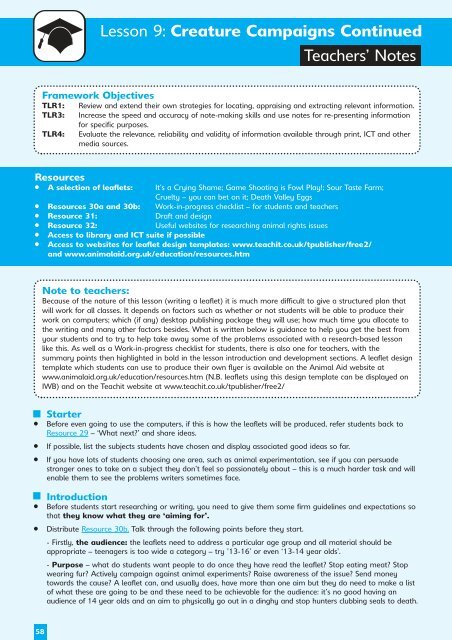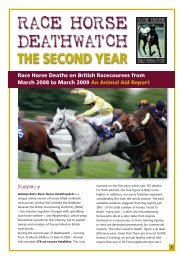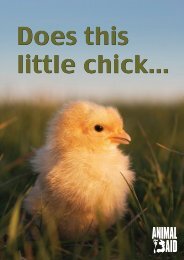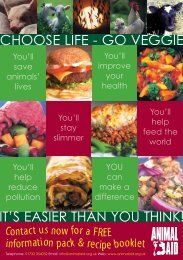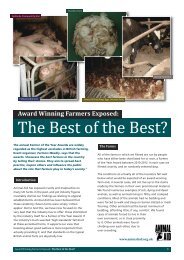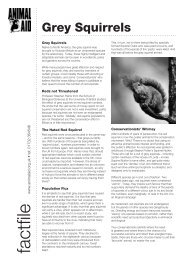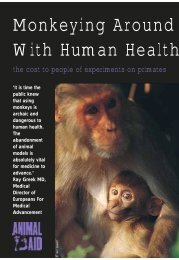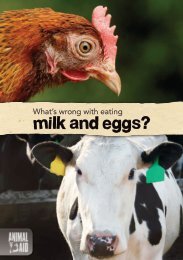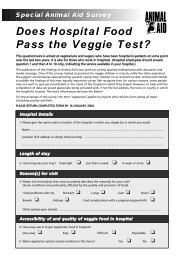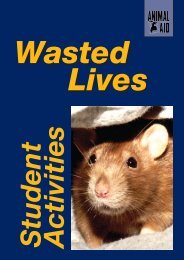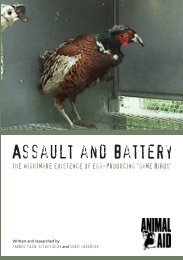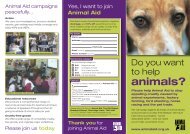English Resource Booklet 2 - Animal Aid
English Resource Booklet 2 - Animal Aid
English Resource Booklet 2 - Animal Aid
You also want an ePaper? Increase the reach of your titles
YUMPU automatically turns print PDFs into web optimized ePapers that Google loves.
Lesson 9: Creature Campaigns ContinuedTeachers’ NotesFramework ObjectivesTLR1:TLR3:TLR4:Review and extend their own strategies for locating, appraising and extracting relevant information.Increase the speed and accuracy of note-making skills and use notes for re-presenting informationfor specific purposes.Evaluate the relevance, reliability and validity of information available through print, ICT and othermedia sources.<strong>Resource</strong>s• A selection of leaflets: It’s a Crying Shame; Game Shooting is Fowl Play!; Sour Taste Farm;Cruelty – you can bet on it; Death Valley Eggs• <strong>Resource</strong>s 30a and 30b: Work-in-progress checklist – for students and teachers• <strong>Resource</strong> 31: Draft and design• <strong>Resource</strong> 32: Useful websites for researching animal rights issues• Access to library and ICT suite if possible• Access to websites for leaflet design templates: www.teachit.co.uk/tpublisher/free2/and www.animalaid.org.uk/education/resources.htmNote to teachers:Because of the nature of this lesson (writing a leaflet) it is much more difficult to give a structured plan thatwill work for all classes. It depends on factors such as whether or not students will be able to produce theirwork on computers; which (if any) desktop publishing package they will use; how much time you allocate tothe writing and many other factors besides. What is written below is guidance to help you get the best fromyour students and to try to help take away some of the problems associated with a research-based lessonlike this. As well as a Work-in-progress checklist for students, there is also one for teachers, with thesummary points then highlighted in bold in the lesson introduction and development sections. A leaflet designtemplate which students can use to produce their own flyer is available on the <strong>Animal</strong> <strong>Aid</strong> website atwww.animalaid.org.uk/education/resources.htm (N.B. leaflets using this design template can be displayed onIWB) and on the Teachit website at www.teachit.co.uk/tpublisher/free2/Starter• Before even going to use the computers, if this is how the leaflets will be produced, refer students back to<strong>Resource</strong> 29 – ‘What next?’ and share ideas.• If possible, list the subjects students have chosen and display associated good ideas so far.• If you have lots of students choosing one area, such as animal experimentation, see if you can persuadestronger ones to take on a subject they don’t feel so passionately about – this is a much harder task and willenable them to see the problems writers sometimes face.Introduction• Before students start researching or writing, you need to give them some firm guidelines and expectations sothat they know what they are ‘aiming for’.• Distribute <strong>Resource</strong> 30b. Talk through the following points before they start.- Firstly, the audience: the leaflets need to address a particular age group and all material should beappropriate – teenagers is too wide a category – try ’13-16’ or even ‘13-14 year olds’.- Purpose – what do students want people to do once they have read the leaflet? Stop eating meat? Stopwearing fur? Actively campaign against animal experiments? Raise awareness of the issue? Send moneytowards the cause? A leaflet can, and usually does, have more than one aim but they do need to make a listof what these are going to be and these need to be achievable for the audience: it’s no good having anaudience of 14 year olds and an aim to physically go out in a dinghy and stop hunters clubbing seals to death.58


